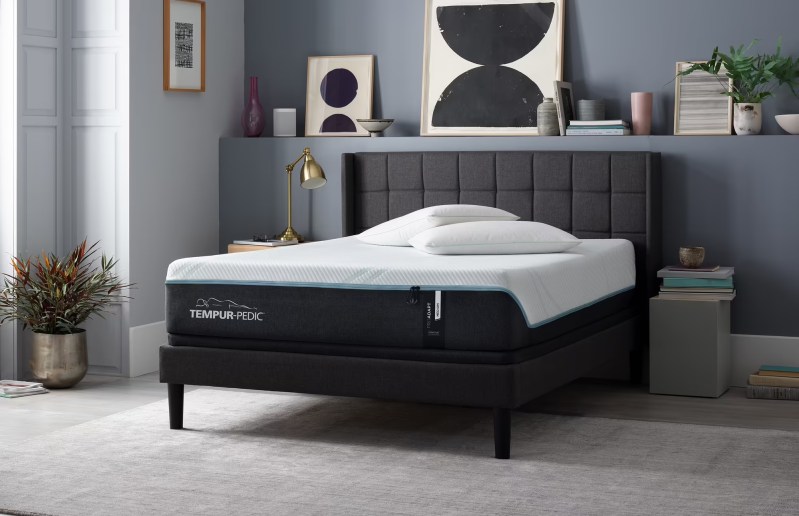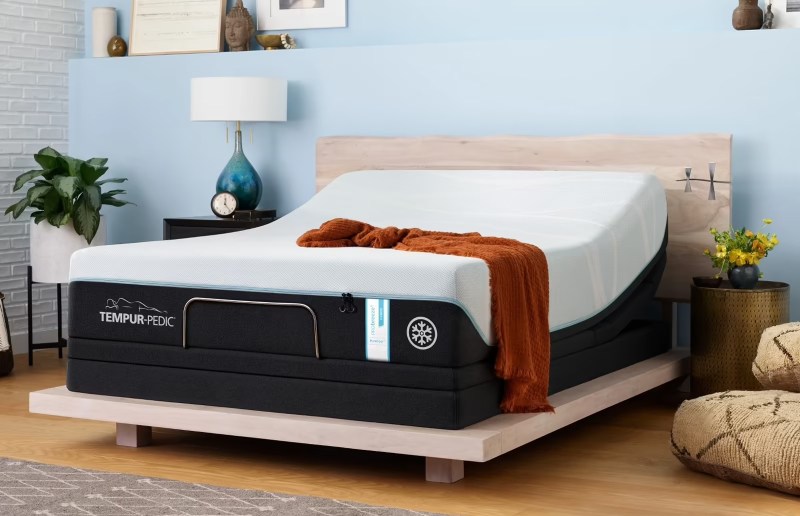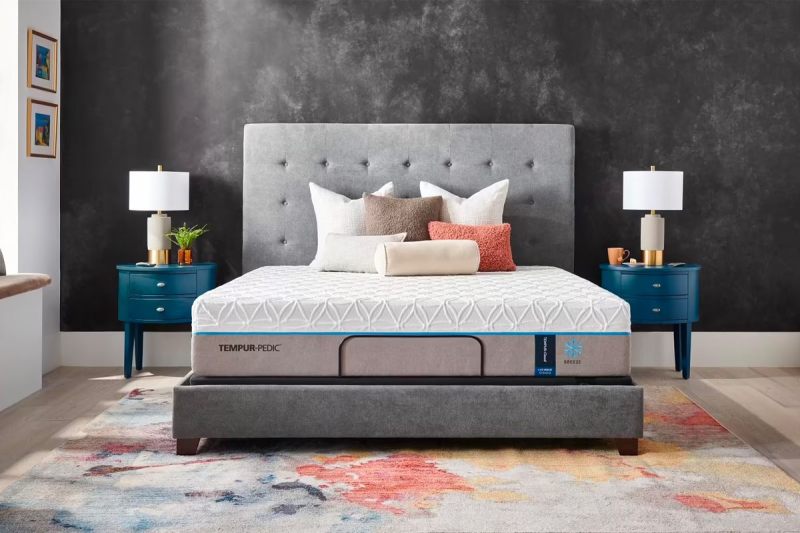
Buying a Tempur-Pedic mattress is a process that should be done with an ample amount of care and consideration. Not only can mattresses be quite a significant financial investment, but because they serve as your foundation for sleeping night after night for what should be many years, it’s extremely important to buy a high-quality, comfortable mattress. After all, a poorly made mattress will break down prematurely and may fail to provide the support, pressure relief, temperature regulation, and comfort you need to get restful sleep. A bad mattress can even cause back, shoulder, hip, or neck pain, and if it does an inadequate job of arresting the transfer of motion, you may find yourself constantly disturbed by a bed partner’s restlessness.
Tempur-Pedic mattresses are among the upper echelon of mattresses in terms of quality, comfort, and effective design, which is why they are consistently one of the most popular mattress purchases every year and adored by nearly every customer. Each Tempur-Pedic mattress model is specifically designed to precisely adapt to the weight, shape, and temperature of your body to eliminate potential pressure points and intimately contour to your body to provide maximal cradling support and comfort. The materials and construction of each mattress minimize motion transfer and enhance airflow and heat dispersion.
Clearly, although Tempur-Pedic mattresses are expensive, they are designed for comfort and to support healthy sleep and are made with premium materials. But, are Tempur-Pedic mattresses a good value? How long do Tempur-Pedic mattresses last? Below, we help answer these important questions to help you have all the information you need before buying a Tempur-Pedic mattress or investing in any new mattress.
What types of mattresses does Tempur-Pedic make?

Tempur-Pedic has three different models of mattresses: The TEMPUR-Adapt and TEMPUR-Breeze collections are its premium lines of traditional mattresses, while the TEMPUR-Cloud collection employs a TEMPUR material designed for fast shipping and doorstep delivery.
True to its name, the TEMPUR-Adapt Mattress series is engineered to conform and adapt to the shape of your body to cradle each anatomical contour and provide even support and pressure across your entire body. The result is a mattress that feels as supportive as it’s comfortable and as stable as it is responsive. The TEMPUR material was invented by NASA and has an advanced cellular structure that is precision-engineered to fully adapt your body weight, shape, and temperature, which yields the most personalized sleep comfort and support. It also has fluid-like properties, allowing it to absorb and distribute increased pressure on bony prominences like the shoulders and hips, which makes it an ideal mattress for side sleepers.
The TEMPUR-Breeze collection is specifically designed to keep you up to 8 degrees cooler at night with a TEMPUR-CM+ material that maximizes airflow and breathability, while the TEMPUR-Cloud Mattress is a new budget option with lighter, more compressible materials.
How long do Tempur-Pedic mattresses last?

In general, innerspring mattresses last the longest, and memory foam mattresses are the least resilient over time. Hybrid mattresses, like Tempur-Pedic mattresses, fall in the middle, depending on the quality of construction and materials. According to buyer reviews and data, as well as representatives at Tempur-Pedic, the average Tempur-Pedic mattress should last roughly 10 years. The “Pro” and “Luxe” models in their collections may last an additional 2-5 years or more. The TEMPUR-Cloud Mattress may last 7-8 years.
Tempur-Pedic backs its mattresses with a 10-year Full Replacement Limited Warranty, which entitles you to free replacement or repair for ten years from the purchase date provided the mattress was purchased from an authorized retailer and the conditions of the warranty have been upheld.
Certain factors affect the expected lifespan of a Tempur-Pedic mattress, such as the body size and shape of the users, sleep position, frequency of use, support structure, how well the mattresses are cared for and cleaned, the environment (humidity), and use of a mattress pad or a mattress protector.
How to extend the life of your mattress

While every mattress will eventually break down and need to be replaced, there are certain things you can do to best care for it and prolong its expected lifespan.
- Enclose your mattress in a mattress protector from day one. A mattress protector is the single most important accessory for your new mattress. It is a thin piece of waterproof material that completely encapsulates the mattress to form a protective barrier that prevents sweat, body oils, liquids, spills, and bacteria from penetrating the mattress. Fluids and dirt can cause mold growth, foul odors, or the material to break down. Mattress protectors can also prevent bedbug infestations and can contain dust mites, chemicals, and other allergens in the mattress.
- Use a proper bed frame or supportive surface underneath your mattress. A supportive foundation prevents a mattress from sagging or experiencing areas of high tension or compression by distributing forces evenly across the surface area of the mattress. The manufacturer should specify which type of bed frame or foundation is ideal for your new mattress.
- Rotate your mattress periodically. Rotating your mattress allows the innerspring and memory foam a chance to decompress by altering the pattern of stress application. This can help prevent premature breakdown and keep the wear and tear on the mattress even. Tempur-Pedic mattresses are not double-sided, which means you cannot flip them, yet rotating them every six months will help ensure even wear.
- Clean your mattress regularly and according to the manufacturer’s instructions. Vacuuming off surface dirt and dust every one to three months can help preserve the mattress’s integrity. If you need to clean a spill or stain off your mattress, avoid harsh chemicals and follow the manufacturer’s instructions for safe removal to avoid damaging the top layers of the mattress.
- Wash your bedding regularly. Body oils, sweat, dirt, bacteria, food particles, and dead skin cells can penetrate a mattress and damage the materials or cause mold and bacterial growth. Fortunately, mattress protectors should prevent such damage, but it’s still a good idea to wash bed linens weekly to reduce the chance of possible damage.
- Don’t use electric blankets. Excessive heat from electric blankets and heating pads can damage the memory foam in the mattress. Use these products sparingly or on low settings at all times.
- Keep pets off the bed. Pet dander, dirt, and oils can penetrate a mattress and cause the materials to break down prematurely.
- Move your mattress with care. Whether moving homes or simply transporting it from one room to another, handle it with care. Do not drop the mattress, and avoid compressing it or placing heavy items on top of it.
- Allow the mattress to soak up the sun occasionally. It may sound a bit strange, but removing the bedding and opening your windows and blinds to allow the sunlight to saturate your mattress is a great way to dry out trapped moisture and prevent mold or mildew growth. It may also reduce allergens and dust mite populations.
- Don’t jump on your bed. It should come as no surprise that the classic warning from parents holds true—jumping on the bed can damage innerspring or memory foam cells, leading to consequences in the support and longevity of the mattress.
How to clean your Tempur-Pedic mattress
There are several ways to clean your Tempur-Pedic mattress, which will help you extend its lifespan. Some of these things are mentioned above, but here are more details.
- Routine vacuuming: Vacuum your mattress at least twice a year with the upholstery attachment to remove dust mites, dead skin cells, and allergens.
- Baking soda deodorize: For a deeper clean, sprinkle baking soda on the surface of the mattress and let it sit for an hour. The baking soda will absorb odors and sweat. Vacuum the baking soda thoroughly afterward.
- Spot cleaning spills: For spills, act quickly to blot up any excess liquid with a clean, absorbent cloth. Don’t scrub, as this can push the liquid further into your Tempur-Pedic mattress. Use a solution of lukewarm water and mild dish soap to dampen a clean cloth and blot the affected area. Then, follow up with a damp cloth with clean water only to remove any soap residue. Let the mattress air dry completely before remaking the bed.
- Addressing pet accidents: For pet accidents, a solution of equal parts white vinegar and water can neutralize odors. Always test the cleaning solution in an inconspicuous area first and let the mattress air dry completely before using it again.



